Family name: Burmanniaceae Blume
Synonym(s): Tripterellaceae Dumort., nom. illeg.
Common name(s): burmannia family
*Number of genera/species: 8/99
List of genera record in GRIN-Global
seed
Fruit a capsulecapsule:
a dry, dehiscent fruit derived from a compound ovary (except Asiatic Gymnosiphon spp.), usually 1–10 mm long, with exception of Campylosiphon (up to 14.5 mm), globoseglobose:
(except Asiatic Gymnosiphon spp.), usually 1–10 mm long, with exception of Campylosiphon (up to 14.5 mm), globoseglobose:
3D shape—more or less spherical to cuneiformcuneiform:
to cuneiformcuneiform:
wedge-shaped
, tereteterete:
approximately circular in cross section; width and thickness approximately equal
 or angledangular:
or angledangular:
2D shape—having sides that meet at acute or obtuse angles
in transection, perianthperianth:
collective term for calyx and corolla of a flower
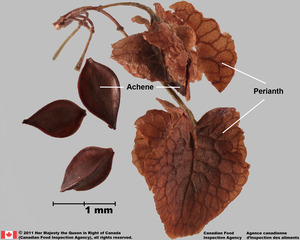 persistent at apexapex:
persistent at apexapex:
the point farthest from the point of attachment, or the "tip" of an organ , sometimes stylestyle:
, sometimes stylestyle:
in a flower, the narrow and elongated part of the pistil between the stigma and the ovary; sometimes persisting in fruit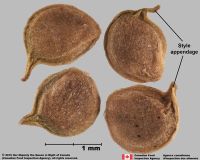 persistent, with many seeds. CapsulesCapsule:
persistent, with many seeds. CapsulesCapsule:
a dry, dehiscent fruit derived from a compound ovary often longitudinally three winged or ribbedribbed:
often longitudinally three winged or ribbedribbed:
surface relief—wide, prominent, linear ridges that are generally rounded and longitudinally situated on the surface . Capsulecapsule:
. Capsulecapsule:
a dry, dehiscent fruit derived from a compound ovary dehiscence is irregular by withering between ribs, transverse by slits between the ribs or wings, loculicidalloculicidal:
dehiscence is irregular by withering between ribs, transverse by slits between the ribs or wings, loculicidalloculicidal:
type of capsular dehiscence, opening longitudinally through the locules (compare septicidal)
 , or septicidalsepticidal:
, or septicidalsepticidal:
type of capsular dehiscence, opening longitudinally by separating between the septa of adjacent carpels
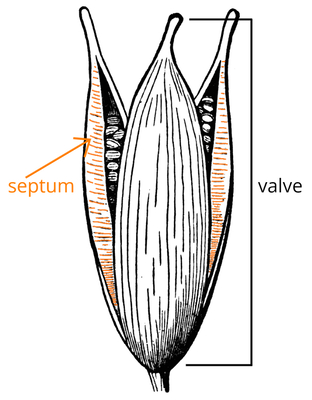 . Pericarppericarp:
. Pericarppericarp:
fruit wall or fruit coat
brown, white, green, yellow, purple, or gray, membranousmembranous:
texture—extremely thin, pliable, and fairly tough
, ribbedribbed:
surface relief—wide, prominent, linear ridges that are generally rounded and longitudinally situated on the surface , reticulatereticulate:
, reticulatereticulate:
surface relief—netted, raised walls or concave grooves forming a net-like surface pattern with flat, concave, or convex interspaces , or wrinkledwrinkled:
, or wrinkledwrinkled:
surface relief—shallow, irregular folds and furrows covering the surface; appearing overall though crumpled and then spread out .
.
Seeds usually globoseglobose:
3D shape—more or less spherical to C-shapedC-shaped:
to C-shapedC-shaped:
2D-shape—semiannulate, curved into the shape of the letter 'C'
, minute and light (dust-like), with tight, colored seed coat. Or rarely seeds are narrowly fusiformfusiform:
spindle-shaped; broadest at the middle and tapering at both ends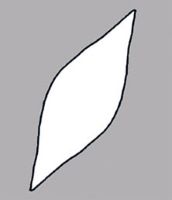 with loose, transparent seed coat (seeds appear white, Dictyostega). Seed wings due to a thin extension of seed coat at both ends. Seed coat, if colored, brown, yellow, gray, green, or white, shinyshiny:
with loose, transparent seed coat (seeds appear white, Dictyostega). Seed wings due to a thin extension of seed coat at both ends. Seed coat, if colored, brown, yellow, gray, green, or white, shinyshiny:
uniformly reflecting a high proportion of incident light at all angles , thin, glabrousglabrous:
, thin, glabrousglabrous:
without hairs
, smooth, reticulatereticulate:
surface relief—netted, raised walls or concave grooves forming a net-like surface pattern with flat, concave, or convex interspaces , sculptured, ribbedribbed:
, sculptured, ribbedribbed:
surface relief—wide, prominent, linear ridges that are generally rounded and longitudinally situated on the surface , or wartywarty:
, or wartywarty:
surface relief—distinct, rounded projections that are large relative to the fruit size; tuberculate, verrucose . Funiculusfuniculus:
. Funiculusfuniculus:
(alt. funicle) stalk connecting the ovule (later seed) to the ovary (later fruit) placenta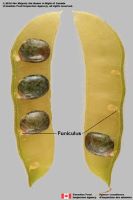 long or short (longer than the seeds, Cymbocarpa).
long or short (longer than the seeds, Cymbocarpa).
Embryo minute, rudimentaryrudimentary:
(of embryo) embryo is small and fills less than a quarter of the seed and can be variable in shapes, such as linear, spatulate, or oval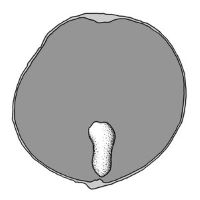 .
.
Endosperm scanty.
| Fruit | |
| Type | capsulecapsule: a dry, dehiscent fruit derived from a compound ovary  |
| Size range | 1–10(–14.5) mm long |
| Shape(s) | globoseglobose: 3D shape—more or less spherical  , ovoidovoid: , ovoidovoid:3D shape—ovate  , ellipsoidellipsoid: , ellipsoidellipsoid:3D shape—elliptic , conicalconical: 3D shape—cone-shaped, with the point of attachment at the broad end 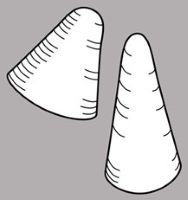 , trigonoustrigonous: , trigonoustrigonous:3D shape—having three faces that meet at distinct angles; triangular in outline , cylindricalcylindrical: 3D shape—a cylinder, with parallel sides and a circular cross-section; tubular or rod-shaped , boat-shaped, cuneiformcuneiform: wedge-shaped |
| Texture | membranousmembranous: texture—extremely thin, pliable, and fairly tough |
| Surface relief | ribbedribbed: surface relief—wide, prominent, linear ridges that are generally rounded and longitudinally situated on the surface  , reticulatereticulate: , reticulatereticulate:surface relief—netted, raised walls or concave grooves forming a net-like surface pattern with flat, concave, or convex interspaces  , wrinkledwrinkled: , wrinkledwrinkled:surface relief—shallow, irregular folds and furrows covering the surface; appearing overall though crumpled and then spread out  |
| Color(s) | brown, white, green, yellow, purple, gray |
| Unique features | Winged or ribbedribbed: surface relief—wide, prominent, linear ridges that are generally rounded and longitudinally situated on the surface  capsulescapsule: capsulescapsule:a dry, dehiscent fruit derived from a compound ovary  with persistent floral tube filledfilled: with persistent floral tube filledfilled:(of embryo) embryo fills the seed interior with the food reserves stored in the cotyledons; small amounts of endosperm may remain around the embryo 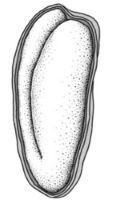 with dustlike seeds. with dustlike seeds. |
| Seed | |
| Size range | 0.2–1 mm long |
| Shape(s) | globoseglobose: 3D shape—more or less spherical  , ovoidovoid: , ovoidovoid:3D shape—ovate  , ellipsoidellipsoid: , ellipsoidellipsoid:3D shape—elliptic , linearlinear: (shape) long, narrow, and uniform in width; (of embryo) embryo is straight and much longer than wide  , fusiformfusiform: , fusiformfusiform:spindle-shaped; broadest at the middle and tapering at both ends  , C-shapedC-shaped: , C-shapedC-shaped:2D-shape—semiannulate, curved into the shape of the letter 'C' |
| Surface relief | smooth, reticulatereticulate: surface relief—netted, raised walls or concave grooves forming a net-like surface pattern with flat, concave, or convex interspaces  , sculptured, ribbedribbed: , sculptured, ribbedribbed:surface relief—wide, prominent, linear ridges that are generally rounded and longitudinally situated on the surface  , wartywarty: , wartywarty:surface relief—distinct, rounded projections that are large relative to the fruit size; tuberculate, verrucose  |
| Color(s) | brown, yellow, gray, green, white |
| Unique features | Dustlike winged seeds. |
| Other | |
| Embryo | miniature |
| Nutritive tissue | endosperm scanty |
Pan- and subtropical.
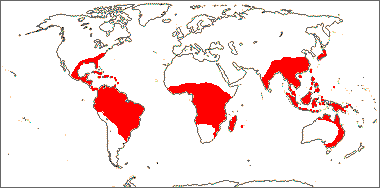
Distribution map courtesy of Angiosperm Phylogeny Website.
Baskin and Baskin 2021Baskin and Baskin 2021:
Baskin C and Baskin J. 2021. Relationship of the lateral embryo (in grasses) to other monocot embryos: A status up-grade. Seed Science Research 31 (3): 199-210. doi:10.1017/S0960258521000209; Cowley 1988Cowley 1988:
Cowley EJ. 1988. Burmanniaceae. In: Polhill RM, ed. Flora of Tropical East Africa. Vol 25. AA Balkema, Rotterdam Netherlands. 9 pp.; Dahlgren et al. 1985Dahlgren et al. 1985:
Dahlgren RMT, Clifford HT, and Yeo PF. 1985. The families of the monocotyledons: structure, evolution, and taxonomy. Springer-Verlag, Berlin. 520 pp.; Davidse et al. 2009–2018Davidse et al. 2009–2018:
Davidse GM, Sousa Sánchez M, Knapp S. and Chiang Cabrera F, eds. 2009–2018. Flora Mesoamericana. Missouri Botanical Garden, St. Louis, MO. Accessed: January–April 2024. URL: http://legacy.tropicos.org/Project/FM; Jonker 1948Jonker 1948:
Jonker FP. 1948. Burmanniaceae (Jonker). Flora Malesiana. Ser. I, Spermatophyta 4 (1): 13-26.; Kirkbride et al. 2006Kirkbride et al. 2006:
Kirkbride JH, Jr, Gunn CR, and Dallwitz MJ. 2006. Family guide for fruits and seeds, vers. 1.0. Accessed September 2020-January 2022. URL: https://nt.ars-grin.gov/seedsfruits/keys/frsdfam/index.cfm .; Kubitzki et al. 1990+Kubitzki et al. 1990+:
Kubitzki K et al., eds. 1990+. The families and genera of vascular plants. 7+ vols. Berlin etc.; Maas et al. 1986Maas et al. 1986:
Maas PJM, Maas-van de Kamer H, Van Benthem J, Snelders HCM, and Rubsamen T. 1986. Burmanniaceae. Flora Neotropica 42: 1-189.; Stevenson and Loconte 1995Stevenson and Loconte 1995:
Stevenson DW and Loconte H. 1995. A cladistic analysis of monocot families. In: Rudall PJ, Cribb PJ, Cutler DF, and Humphries CJ, eds. Monocotyledons: Systematics and Evolution. Royal Botanic Gardens, Kew.; Takhtajan 2009Takhtajan 2009:
Takhtajan A. 2009. Flowering plants: Second edition. Springer Nature, Switzerland. 871 pp.; Watson and Dallwitz 1992+Watson and Dallwitz 1992+:
Watson L and Dallwitz MJ. 1992+. The families of flowering plants: descriptions, illustrations, identification, and information retrieval. Version: 6th Accessed September 2020-September 2022. URL: delta-intkey.com; Wright 1913Wright 1913:
Wright CH. 1913. Burmanniaceae. In: Thiselton-Dyer WT, ed. Flora Capensis: Being a Systematic Description of the Plants of the Cape Colony, Caffraria and Port Natal, and Neighbouring Territories. Vol. 5, Part 3. L. Reeve, Kent UK. https://doi.org/10.5962/bhl.title.821
*The number of genera and species is based on Christenhusz and Byng 2016Christenhusz and Byng 2016:
Christenhusz MJM and Byng JW. 2016. The number of known plant species in the world and its annual increase. Phytotaxa 261 (3): 201-217. https://doi.org/10.11646/phytotaxa.261.3.1, which may differ from the number of genera in GRIN-Global.